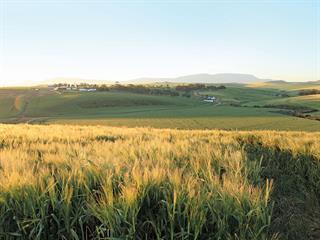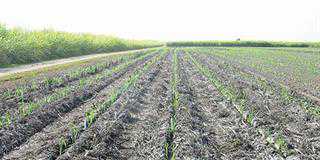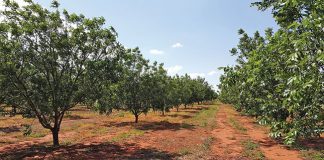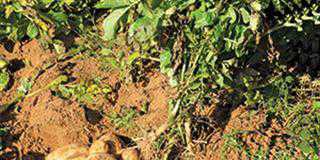
From 1996 to 2001, Southern Cape farmers suffered major production losses due to adverse climate conditions. Swellendam farmer, Michael Dippenaar, recalls the tough times he went through on his farms near Swellendam.
“We suffered drought in 1996 and in 1997 production looked promising, but a heat wave in September killed everything,” he says. “With the abolishment of control boards and in the absence of sound marketing mechanisms, farmers were at the mercy of only one company to buy barley. This was unsuitable for brewing, though, and eventually realised only about R200/t.”
In 2000, the area received hardly any rain, while in 2001 it suffered “the mother of all droughts”, Michael recalls. Farmers were left to their own devices and had to compete with highly subsidised imported products. “If that wasn’t enough, banks lost their appetite for agricultural business in the Southern Cape,” he says.
New look at conservation
Then Michael noticed the success neighbouring farmers were having with conservation farming and started experimenting with this method on part of his operation in 2001. At that stage, conservation farming primarily consisted of planting in stubble lands. Michael used a Flexicoil machine with tines that had a breakaway action, allowing him to place seed into stubble without having to work the land beforehand. A prickle harrow towed behind the machine covered the seed, while a roller compacted the soil.
Although quite new at the time, the technology was crude in comparison with the latest planting technology (see box). Despite this, there was a striking difference in the 2002 yield of the lands where Flexicoil was used and those where traditional cultivation practices were used. This resulted in Michael re-evaluating his farming practices and he converted to conservation farming by 2003.
“We realised that conservation farming was one of the best ways for a farmer to reduce climatic risk as it improved the soil’s water-retention capacity while reducing evaporation,” he explains. “It’s obviously not like waving a magic wand which will completely prevent crop loss during adverse climatic conditions, though.”
He says that if they had employed conservation farming methods during the difficult years between 1996 and 2001, they would still have been able to produce an average crop. “Refining conservation farming in combination with new improved technology took us to a whole new level of production in 2010,” he recalls.
From 2004 to 2010 Michael’s average wheat yield was just below 2t/ ha, but it increased to 3,59t/ ha between 2011 and 2014. Barley followed the same trend, increasing from 2,05t/ha to 4,18t/ha over the same period.
The change-over
When Michael began farming with his father, MC, in 1975, they ran stud and commercial Merino flocks as their main source of income. To spread the risk and boost the slaughtering percentage, they also established a SA Mutton Merino stud and a commercial flock. The stud flock eventually developed into one of the largest SA Mutton Merino studs in the country.
In those days, cash crops represented a relatively small part of the operation. The sheep flock peaked at 10 000 ewes, young ewes and lambs at the height of production in 2010. Michael and his son, Neethling, decided to reduce the numbers. Today, only 2 500 ewes remain.
“We did the sums and realised we couldn’t afford to run so many sheep, as they would be heavy on the land,” Michael explains. “Space is also limited. During times of feed shortages in April and September, we had to buy in. It made economic sense to downscale. Gross profit of sheep [production] in our area is about R1 500/ha, while for wheat and barley it is about R5 000/ha.”
Michael is considering either buying in-lamb ewes or sourcing them from their Karoo farm near De Aar which the family bought in 2011. Michael adds that their land is too valuable to use for raising young ewes. “Locally and internationally, it is becoming a trend for some producers to focus only on one facet of animal production,” he explains.
“For example, some sheep farmers only supply good quality replacement ewes to the market.”
The Dippenaars are not thinking of doing away with the Dohne Merino flock altogether, as sheep still add value to crop production by grazing stubble lands, thereby utilising the economic potential of lupins and oats which form part of the crop rotation system. Sheep also help keep the lands clean by picking up and eating seeds.
“However, we must manage them properly to prevent overgrazing, and remove them from the lands as soon as it starts raining to prevent compaction. This isn’t always easy,” Neethling says.
Grain production
With reduced numbers of sheep on lucerne in the area, this crop has been reduced by at least half, depending on specific production conditions. In contrast, wheat and barley production has increased to 67% of total production.
“We realised that land being transitioned from the lucerne phase to the cash crop phase of the rotation cycle is especially vulnerable to severe weather due to the lack of soil cover,” Neethling explains. “Grain on these lands is vulnerable to drought during the growing phase. Lucerne is reserved only for lands with severe weed problems, such as stick grass (Aristida spp.), while the rest of the land is under continuous cropping with a typical rotation cycle of wheat, barely, canola, and then wheat, barley and lupins.”
However, the Dippenaars allow the lands to ‘guide’ their rotation decisions. On lands without weed problems on which barley achieves a high yield, barley may be planted twice before introducing canola into the rotation system. Neethling says it is possible to plant barley more often in a rotation system using new varieties such as Agulhas and Hessequa that are more disease-resistant than the older cultivars. New fungicides now also make it more economically viable to plant barley twice during a cycle.
Other crops in the rotation are valuable in maintaining sustainable production levels. Canola is the most profitable of these and is especially useful for managing grass weeds. On more marginal soil, oats can partially replace canola to diversify risk. Lupins are less profitable, but seed inoculated with Rhizobium before planting enables these symbiotic nitrogen-fixing bacteria to bind atmospheric nitrogen in the soil.
The Dippenaars plant lupins on high-potential lands to boost the growth of the corps that will follow in the rotation cycle, as well as on lands where sheep will forage in winter. Oats is planted instead of canola on small areas of lower potential soil.
The Dippenaars have been experimenting with sweet lupins as green manure to improve soil condition, slashing the lupin plants with a brush cutter before the pods are shed and working the material into the soil towards the end of August. Sheep are kept out of these lands but are stocked at a density of 10 ewes/ ha between May and August and left to graze on lands with mixture of 50kg/ha bitter lupin seed and 10kg/ha oats.
“We use bitter lupins as this variety is less tasty than sweet lupins. “This ensures that the sheep don’t [destroy] all the plant material,” says Michael.
Soil nutrition
The production area is divided into different zones, each consisting of grids that are 2ha in size. Soil sample analysis is undertaken in these zones over four years to identify nutrient deficiency and variation.
The main purpose of the soil analysis, however, is to correct any calcium deficiency before planting. Sand collected from the coastal town of Witsand is used to address this deficiency. It consists of fine marine shells that have a richer, more diverse mineral composition than that found in any chemical source of calcium, Michael explains.
The phosphate level is corrected with mono-ammonium phosphates (MAP) after planting. Michael explains that phosphate deficiency in high-potential soil is characterised by soil becoming depleted during high production levels. The added nitrogen in MAP is well used by plants in such areas.
Chicken manure is added to lower potential soil and in areas that show a potassium shortage. Organic fertiliser helps counteract the buffering effect of the soil, while contributing to building soil nutrient levels.
At planting, a mixture of MAP, ammonium sulphate and urea is used. Areas with a potassium deficiency also receive potassium sulphate. The fertiliser is placed in bands in every row below the seed. A second application of nitrogen follows four to six weeks after germination, depending on the ‘history’ of the land, production season and rotation cycle. Soil on the farms tend to be deficient in copper, zinc, manganese and boron. To address this, these micro-elements are added to the fertiliser applied during planting.
A periodic sulphur deficiency is also addressed, as it can have a negative impact on nitrogen use. Leaf analysis conducted throughout the production season indicate whether this deficiency is addressed through foliar spraying.
Michael says conservation agriculture has taken his farming enterprise to a whole new level and adds that farmers who have not yet converted are playing with fire: “You cannot afford to farm without it. The climatic risks are simply too high.”
Email Michael Dippenaar at [email protected].













